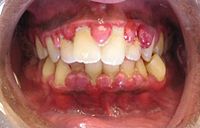
Photo from wikipedia
The assortment of periodontal and implant-related treatments has been continuously improved over the last 50 years. Once the decision-making process has been established and the treatment procedure applied, the partial or… Click to show full abstract
The assortment of periodontal and implant-related treatments has been continuously improved over the last 50 years. Once the decision-making process has been established and the treatment procedure applied, the partial or complete resolution of the problem (eg, periodontal probing depth reduction, clinical attachment level gain, gingival recession reduction, dental hypersensitivity decrease) and a diagnosis change with no or minimal occurrence of adverse events (ie, complications, harms, technical errors, or adverse/side effects) can be expected. The clear identification of the potential types of adverse effects, complications, or even errors is important for contemporary decision-making processes, as they may be related to different local, systemic, and technical aspects. This chapter focused on four core components: (a) providing periodontal definitions for errors, complications, harms, and side effects; (b) defining the types of risk and the clinical impact of adverse effects, errors, and complications in periodontal and peri-implant therapies; (c) evaluating the influence of accidental errors versus the lack of a proper treatment planning; and (d) reporting on the importance of establishing the "net benefit ratio" between the clinical improvements promoted by the therapy and the occurrence of potential adverse events.
Journal Title: Periodontology 2000
Year Published: 2022
Link to full text (if available)
Share on Social Media: Sign Up to like & get
recommendations!